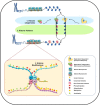A three layered histone epigenetics in breast cancer metastasis
- PMID: 32257110
- PMCID: PMC7106732
- DOI: 10.1186/s13578-020-00415-1
A three layered histone epigenetics in breast cancer metastasis
Abstract
Thanks to the advancement in science and technology and a significant number of cancer research programs being carried out throughout the world, the prevention, prognosis and treatment of breast cancer are improving with a positive and steady pace. However, a stern thoughtful attention is required for the metastatic breast cancer cases-the deadliest of all types of breast cancer, with a character of relapse even when treated. In an effort to explore the less travelled avenues, we summarize here studies underlying the aspects of histone epigenetics in breast cancer metastasis. Authoritative reviews on breast cancer epigenetics are already available; however, there is an urgent need to focus on the epigenetics involved in metastatic character of this cancer. Here we put forward a comprehensive review on how different layers of histone epigenetics comprising of histone chaperones, histone variants and histone modifications interplay to create breast cancer metastasis landscape. Finally, we propose a hypothesis of integrating histone-epigenetic factors as biomarkers that encompass different breast cancer subtypes and hence could be exploited as a target of larger population.
Keywords: Breast cancer; Chaperone; Histone; Metastasis; Modification; Variants.
© The Author(s) 2020.
Conflict of interest statement
Competing interestsThe authors declare no competing of interests.
Figures



References
-
- Scully OJ, Bay BH, Yip G, Yu Y. Breast cancer metastasis. Cancer Genom Proteom. 2012;9:311–320. - PubMed
Publication types
LinkOut - more resources
Full Text Sources

